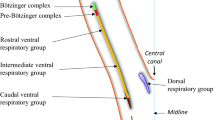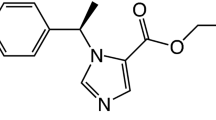Abstract
The hyperpolarization-activated cation current (I h) in rat pituitary lactotrophs (GH3 cells) was characterized. Tramadol-induced block of this current was investigated. Effects of various related compounds on I h in GH3 cells were also compared. Tramadol caused a time- and concentration-dependent reduction in the amplitude of I h with an IC50 value of 13.6 μM. ZD7288 (30 μM), CsCl (2 mM), and propofol (30 μM) were effective in suppressing the amplitude of I h. 2′,5′-dideoxyadenosine (100 μM) suppressed I h, while sp-cAMPS (100 μM) had no effect on it. Tramadol (10 μM) shifted the activation curve of I h to a more negative potential by approximately −20 mV, although no change in the slope factor was observed. Under current-clamp configuration, tramadol (10 μM) could reduce the firing frequency of action potentials. Intracellular Ca2+ measurements revealed its ability to reduce spontaneous Ca2+ oscillations in GH3 cells. The results suggests that during cell exposure to tramadol used at clinically relevant concentration, the tramadol-mediated inhibition of I h could be direct and mediated via a non-opioid mechanism and would be one of the ionic mechanisms underlying reduced cell excitability.







Similar content being viewed by others
References
Accili EA, Proenza C, Baruscotti M, DiFrancesco D (2002) From funny current to HCN channels: 20 years of excitation. News Physiol Sci 17:32–37
Bennett BD, Callaway JC, Wilson CJ (2000) Intrinsic membrane properties underlying spontaneous tonic firing in neostriatal cholinergic interneurons. J Neurosci 20:8493–8503
Bie B, Peng Y, Zhang Y, Pan ZZ (2005) cAMP-mediated mechanisms for pain sensitization during opioid withdrawal. J Neurosci 25:3824–3832
Cacheaux LP, Topf N, Tibbs GR, Schaefer UR, Levi R, Harrison NL, Abbott GW, Goldstein PA (2005) Impairment of hyperpolarization-activated, cyclic nucleotide-gated channel function by the intravenous general anesthetic propofol. J Pharmacol Exp Ther 315:517–525
Chen X, Shu S, Bayliss DA (2005) Suppression of I h contributes to propofol-induced inhibition of mouse cortical pyramidal neurons. J Neurophysiol 94:3872–3883
Close BR (2005) Tramadol: does it have a role in emergency medicine? Emerg Med Australas 17:73–83
DiFrancesco D (2006) Serious workings of the funny current. Prog Biophys Mol Biol 90:13–25
Garrido MJ, Valle M, Campanero MA, Calvo R, Trocóniz IF (2000) Modeling of the in vivo antinociceptive interaction between an opioid agonist, (+)-O-desmethyltramadol, and a monoamine reuptake inhibitor, (−)-O-desmethyltramadol, in rats. J Pharmacol Exp Ther 295:352–359
Gillen C, Haurand M, Kobelt DJ, Wnendt S (2000) Affinity, potency and efficacy of tramadol and its metabolites at the cloned human μ-opioid receptor. Naunyn-Schmiedeberg’s Arch Pharmacol 362:116–121
Irisawa H, Brown HF, Giles W (1993) Cardiac pacemaking in the sinoatrial node. Physiol Rev 73:197–227
Ishii TM, Takano M, Ohmori H (2001) Determinants of activation kinetics in mammalian hyperpolarization-activated cation channels. J Physiol 537:93–100
Kaupp UB, Seifert R (2001) Molecular diversity of pacemaker ion channels. Annu Rev Physiol 63:235–257
Kretschmannova K, Gonzalez-Iglesias AE, Tomić M, Stojilkovic SS (2006) Dependence of hyperpolarization-activated cyclic nucleotide-gated channel activity on basal cyclic adenosine monophosphate production in spontaneous firing GH3 cells. J Neuroendocrinol 18:485–493
Liu YC, Lo YK, Wu SN (2003) Stimulatory effects of chlorzoxazone, a centrally acting muscle relaxant, on large conductance calcium-activated potassium channels in pituitary GH3 cells. Brain Res 959:86–97
Ludwig A, Budde T, Stieber J, Moosmang S, Wahl C, Holthoff K, Langebartels A, Wotjak C, Munsch T, Zong X, Feil S, Feil R, Lancel M, Chien KR, Konnerth A, Pape HC, Biel M, Hofmann F (2003) Absence epilepsy and sinus dysrhythmia in mice lacking the pacemaker channel HCN2. EMBO J 22:216–224
Ogata J, Minami K, Uezono Y, Okamoto T, Shiraishi M, Shigematsu A, Ueta Y (2004) The inhibitory effects of tramadol on 5-hydroxytryptamine type 2C receptors expressed in Xenopus oocytes. Anesth Analg 98:1401–1406
Pál B, Pór A, Szucs G, Kovács I, Rusznák Z (2003) HCN channels contribute to the intrinsic activity of cochlear pyramidal cells. Cell Mol Life Sci 60:2189–2199
Pan ZZ (2003) κ-Opioid receptor-mediated enhancement of the hyperpolarization-activated current (I h) though mobilization of intracellular calcium in rat nucleus raphe magnus. J Physiol 548:765–775
Raimundo JM, Sudo RT, Pontes LB, Antunes F, Trachez MM, Zapata-Sudo G (2006) In vitro and in vivo vasodilator activity of racemic tramadol and its enantiomers in Wistar rats. Eur J Pharmacol 530:117–123
Robinson RB, Siegelbaum SA (2003) Hyperpolarization-activated cation currents: from molecules to physiological function. Annu Rev Physiol 65:453–480
Shiraishi M, Minami K, Uezono Y, Yanagihara N, Shigematsu A, Shibuya I (2002) Inhibitory effects of tramadol on nicotinic acetylcholine receptors in adrenal chromaffin cells and in Xenopus oocytes expressing α7 receptors. Br J Pharmacol 136:207–216
Simasko SM (1994) A background sodium conductance is necessary for spontaneous depolarizations in rat pituitary cell line GH3. Am J Physiol 266:C709–C719
Simasko SM, Sankaranarayanan S (1997) Characterization of a hyperpolarization-activated cation current in rat pituitary cells. Am J Physiol 272:E405–E414
Stieber J, Herrmann S, Feil S, Loster J, Feil R, Biel M, Hofmann F, Ludwig A (2003) The hyperpolarization-activated channel HCN4 is required for the generation of pacemaker action potentials in the embryonic heart. Proc Natl Acad Sci USA 100:15235–15240
Stieber J, Stöckl G, Herrmann S, Hassfurth B, Hofmann F (2005) Functional expression of the human HCN3 channel. J Biol Chem 280:34635–34643
Stojilkovic SS, Zemkova H, Van Goor F (2005) Biophysical basis of pituitary cell type-specific Ca2+ signaling-secretion coupling. Trends Endocrinol Metab 16:152–159
Svoboda KR, Lupica CR (1998) Opioid inhibition of hippocampal interneurons via modulation of potassium and hyperpolarization-activated cation (I h) currents. J Neurosci 18:7084–7098
Tian L, Shipston MJ (2000) Characterization of hyperpolarization-activated cation currents in mouse anterior pituitary, AtT20 D16:16 corticotropes. Endocrinology 141:2930–2937
Tsai YC, Chang PJ, Jou IM (2001) Direct tramadol application on sciatic nerve inhibits spinal somatosensory evoked potentials in rats. Anesth Analg 92:1547–1551
Tsai TY, Tsai YC, Wu SN, Liu YC (2005) Tramadol-induced blockade of delayed rectifier potassium current in NG108-15 neuronal cells. Eur J Pain. 10:597–601
Vasilyev DV, Shan Q, Lee Y, Mayer SC, Bowlby MR, Strassle BW, Kaftan EJ, Rogers KE, Dunlop J (2007) Direct inhibition of I h by analgesic loperamide in rat DRG neurons. J Neurophysiol 97:3713–3721
Wilson CJ (2005) The mechanism of intrinsic amplification of hyperpolarizations and spontaneous bursting in striatal cholinergic interneurons. Neuron 45:575–585
Wu SN (2003) Large-conductance Ca2+-activated K+ channels: physiological role and pharmacology. Curr Med Chem 10:649–661
Wu SN, Chang HD (2006) Diethyl pyrocarbonate, a histidine-modifying agent, directly stimulates activity of ATP-sensitive potassium channels in pituitary GH3 cells. Biochem Pharmacol 171:615–623
Wu SN, Li HF, Jan CR (1998) Regulation of Ca2+-activated nonselective cationic currents in rat pituitary GH3 cells: involvement in L-type Ca2+ current. Brain Res 812:133–141
Wu SN, Li HF, Chiang HT (2000) Stimulatory effects of δ-hexachlorocyclohexane on Ca2+-activated K+ currents in GH3 lactotrophs. Mol Pharmacol 57:865–874
Acknowledgements
This work was partly supported by National Science Council (NSC-92–2320-B-075B-001, NSC-95-2314-B-006-092), Taiwan.
Author information
Authors and Affiliations
Corresponding author
Rights and permissions
About this article
Cite this article
Liu, YC., Wang, YJ., Wu, PY. et al. Tramadol-induced block of hyperpolarization-activated cation current in rat pituitary lactotrophs. Naunyn-Schmied Arch Pharmacol 379, 127–135 (2009). https://doi.org/10.1007/s00210-008-0353-0
Received:
Accepted:
Published:
Issue Date:
DOI: https://doi.org/10.1007/s00210-008-0353-0




